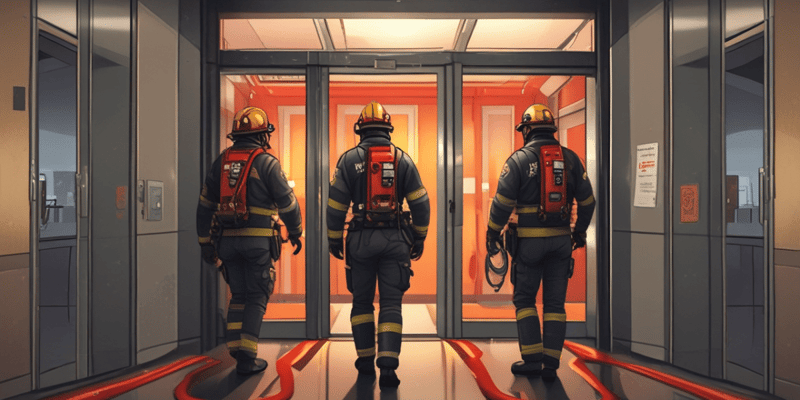Podcast
Questions and Answers
What is the primary function of door restrictors in elevators?
What is the primary function of door restrictors in elevators?
Which of the following steps must be performed first during an elevator rescue for a true emergency?
Which of the following steps must be performed first during an elevator rescue for a true emergency?
If an elevator door only moves a few inches and then stops, what should be checked immediately?
If an elevator door only moves a few inches and then stops, what should be checked immediately?
What action should be taken when making verbal contact with passengers in a stuck elevator?
What action should be taken when making verbal contact with passengers in a stuck elevator?
Signup and view all the answers
Which statement correctly describes door operators in elevators?
Which statement correctly describes door operators in elevators?
Signup and view all the answers
In a situation requiring rescue, which type of elevator provides an option for manual lowering?
In a situation requiring rescue, which type of elevator provides an option for manual lowering?
Signup and view all the answers
What must be done before proceeding with any other steps in elevator rescue procedures?
What must be done before proceeding with any other steps in elevator rescue procedures?
Signup and view all the answers
When does leap frogging' or 'polling' become necessary?
When does leap frogging' or 'polling' become necessary?
Signup and view all the answers
What is the first step to be taken after advising passengers to stay clear of the car doors during a manual lowering rescue?
What is the first step to be taken after advising passengers to stay clear of the car doors during a manual lowering rescue?
Signup and view all the answers
What should be done if the car does not lower after the manual lowering valve is opened?
What should be done if the car does not lower after the manual lowering valve is opened?
Signup and view all the answers
When can extra leverage be required during the rescue process?
When can extra leverage be required during the rescue process?
Signup and view all the answers
What is the primary action required for a non-emergency elevator rescue?
What is the primary action required for a non-emergency elevator rescue?
Signup and view all the answers
Which tool is mentioned as potentially useful for opening the manual lowering valve?
Which tool is mentioned as potentially useful for opening the manual lowering valve?
Signup and view all the answers
Which of the following describes step 2 during a true emergency elevator situation?
Which of the following describes step 2 during a true emergency elevator situation?
Signup and view all the answers
In the case of a true emergency involving an elevator, which factor is NOT mentioned as a possible threat to passengers?
In the case of a true emergency involving an elevator, which factor is NOT mentioned as a possible threat to passengers?
Signup and view all the answers
What is another name for a traction elevator?
What is another name for a traction elevator?
Signup and view all the answers
What are two key points to remember when trying to remove someone from an elevator?
What are two key points to remember when trying to remove someone from an elevator?
Signup and view all the answers
What is a important step for a true emergency elevator rescue?
What is a important step for a true emergency elevator rescue?
Signup and view all the answers
Which elevator feature should be activated in a non-emergency if the elevator does not return to the designated level?
Which elevator feature should be activated in a non-emergency if the elevator does not return to the designated level?
Signup and view all the answers
During a true emergency, alongside contacting an elevator mechanic, what additional resource is dispatched?
During a true emergency, alongside contacting an elevator mechanic, what additional resource is dispatched?
Signup and view all the answers
For which type of elevator is it essential to utilize a hoist motor and traction sheave?
For which type of elevator is it essential to utilize a hoist motor and traction sheave?
Signup and view all the answers
What is the initial action required before performing a car top emergency exit rescue?
What is the initial action required before performing a car top emergency exit rescue?
Signup and view all the answers
What method should be used to remove trapped passengers during a car top emergency exit rescue?
What method should be used to remove trapped passengers during a car top emergency exit rescue?
Signup and view all the answers
When utilizing the leap frogging method, who must be present at the hall doors of the floor below?
When utilizing the leap frogging method, who must be present at the hall doors of the floor below?
Signup and view all the answers
What must be done after opening the top floor doors during the leap frogging process?
What must be done after opening the top floor doors during the leap frogging process?
Signup and view all the answers
In Step 4b, what is the correct action to open the elevator car doors?
In Step 4b, what is the correct action to open the elevator car doors?
Signup and view all the answers
Which device can be used to unlock the hall doors at the pick-up rollers?
Which device can be used to unlock the hall doors at the pick-up rollers?
Signup and view all the answers
What must rescuers be aware of when opening the elevator car doors in Step 4b?
What must rescuers be aware of when opening the elevator car doors in Step 4b?
Signup and view all the answers
Which type of elevator can utilize the car top exit rescue method?
Which type of elevator can utilize the car top exit rescue method?
Signup and view all the answers
Study Notes
Elevator Rescue Procedures
- Elevator rescues are categorized into Non-Emergency (no immediate danger) and True Emergency (imminent danger).
Non-Emergency Procedures
- Passengers in a stopped elevator generally need reassurance and assistance from TFD personnel.
- Steps include contacting an elevator mechanic and activating the fire service feature Phase I to potentially bring the elevator down.
- If Phase I does not work, wait for the elevator mechanic for further action.
True Emergency Procedures
- In imminent danger situations, involve the Rescue Task Force for specialized equipment.
- Establish verbal contact with trapped passengers to provide reassurance and assess any medical emergencies.
- There are two types of elevators: Traction (cabled with a hoist motor) and Hydraulic (operated by hydraulic fluid).
Door Mechanisms
- Door Restrictors: Prevent the opening of elevator doors between floors; can be mechanical or electromechanical.
- Door Operators: Typically open by pulling; if limited movement occurs, check for door restrictors.
Steps for True Emergency Rescues
- Step 1: Lock out power by disconnecting power in the elevator mechanical room before any other actions.
- Step 2: Make contact with passengers, reassure them, and check for medical emergencies.
- Step 3: Decide on the rescue method based on elevator type and accessibility.
Rescue Techniques
- Car Top Exit (Step 4a): Access top of the car using a ladder after opening the hall door and car top exit.
- Door Opening (Step 4b): Open hall and car doors to extract passengers; be cautious of door restrictors.
- Leap Frogging (Step 4c): Required when limited access exists; involves unlocking doors from above or below using an elevator pole.
- Manual Lowering (Step 4d - hydraulic only): Safest for hydraulic elevators; requires opening valves and ensuring clear car doors before assisting passengers.
Important Notes
- Ensure that any manual lowering of a hydraulic elevator is done safely with no tools typically required; in case of issues, wait for the mechanic.
- Effective communication and reassurance to trapped passengers are critical throughout rescue procedures.
Studying That Suits You
Use AI to generate personalized quizzes and flashcards to suit your learning preferences.
Description
Explore the strategic and tactical considerations for elevator rescues as outlined by the Tulsa Fire Department. This quiz covers both non-emergency and true-emergency scenarios to enhance understanding and preparedness for fire and rescue personnel.




